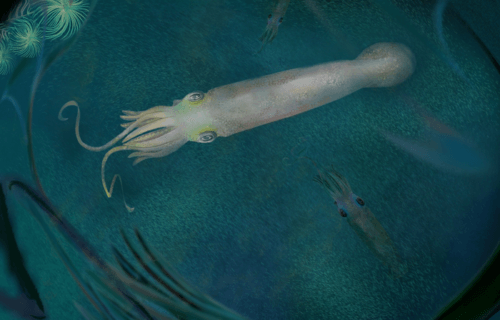
NEW YORK — The oldest ancestors of modern-day octopuses and vampire squids had an astounding 10 arms instead of the usual eight, according to a team from Yale and the American Museum of Natural History. Putting on a sweater must have been a nightmare.
Moreover, this groundbreaking work pushes back the entire known evolutionary timeline for vampyropods by another 82 million years. Researchers estimate that the remarkably well persevered vampire squid fossil is roughly 328 million years-old.
“This is the first and only known vampyropod to possess 10 functional appendages,” says lead study author Christopher Whalen, a postdoctoral researcher in the Museum’s Division of Paleontology and a National Science Foundation postdoctoral fellow in Yale’s Department of Earth & Planetary Sciences, in a media release.
Vampyropods are soft-bodied cephalopods usually featuring eight functional arms in addition to an internalized chitinous shell — or fin supports. Due to their lack of hard structures, there are few fossil records of Vampyropoda. While this research is new, a team actually discovered the fossil in Montana in 1988 and eventually donated it to the Royal Ontario Museum (ROM).
Study co-author Neil Landman, a curator emeritus in the Royal Ontario Museum’s Division of Paleontology, was the first to actually ID the fossil specimen as a completely new genus and species dating back roughly 328 million years. That timeline makes the fossil the oldest known vampyropod, consequently extending the entire fossil record of the group by another 82 million years.
Prehistoric arms race
The other big story here is the fossil’s two extra arms. All 10 arms, incredibly, even have their suckers intact after all this time. This seemingly confirms earlier scientific estimations stating the common ancestor of vampyropods likely had 10 arms.
“The arm count is one of the defining characteristics separating the 10-armed squid and cuttlefish line (Decabrachia) from the eight armed octopus and vampire squid line (Vampyropoda). We have long understood that octopuses achieve the eight arm count through elimination of the two filaments of vampire squid, and that these filaments are vestigial arms,” Whalen explains. “However, all previously reported fossil vampyropods preserving the appendages only have 8 arms, so this fossil is arguably the first confirmation of the idea that all cephalopods ancestrally possessed ten arms.”
In particular, two of the cephalopod’s arms appear to be longer than the others, and the torpedo shape of its body is “reminiscent of today’s squids.”
The presidential squid
Researchers dubbed the fossil Syllipsimopodi bideni — a reference to the Greek words for prehensile and foot, as well as President Joe Biden, who just had his inauguration at the time of the study’s initial submission. Scientists consider the fossil to be the oldest cephalopod to feature suckers allowing the appendages to actually grab and hold objects or prey, thus the references to the Greek “syllípsimos” for “prehensile” and “pódi” for “foot”.
“Syllipsimopodi may have filled a niche more similar to extant squids, a midlevel aquatic predator,” Landman adds. “It is not inconceivable that it might have used its sucker-laden arms to pry small ammonoids out of their shells or ventured more inshore to prey on brachiopods, bivalves, or other shelled marine animals.”
All in all, the fossil’s estimated age, phylogenetic position, and characteristics strongly suggest that the currently accepted arguments regarding vampyropod origins are off by a notable margin. The research team proposes that scientists develop an entirely new model for coleoid (internally shelled cephalopod) evolution.
The study is published in the journal Nature Communications.
